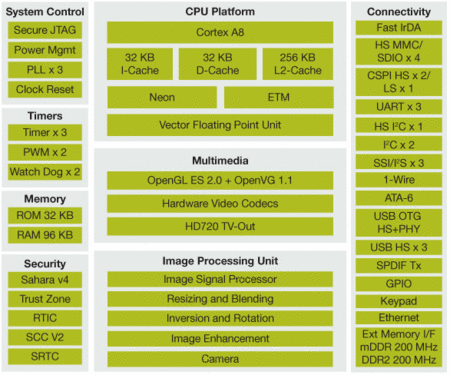Freescale touts Android on ARM netbook design
Feb 16, 2009 — by Eric Brown — from the LinuxDevices Archive — 4 views Freescale Semiconductor is demonstrating an Ubuntu Linux-based netbook reference design based on its ARM Cortex A8-based i.MX515 system-on-chip (SoC). Additionally, Freescale announced Android and Xandros Linux ports to the chip, support from Phoenix Technogies's HyperSpace fast-boot technology, and support for… 3G modules from Wavecom and Option.
Freescale Semiconductor is demonstrating an Ubuntu Linux-based netbook reference design based on its ARM Cortex A8-based i.MX515 system-on-chip (SoC). Additionally, Freescale announced Android and Xandros Linux ports to the chip, support from Phoenix Technogies's HyperSpace fast-boot technology, and support for… 3G modules from Wavecom and Option.
(Click for larger view of Freescale netbook ref. design)
When Freescale announced the i.MX515 system-on-chip in early January, it mentioned that a development board for the SoC would be coming soon, sourced from Pegatron Technology. Equipped with an Ubuntu Linux distribution from Canonical, the board is available now, Freescale said. The board also appears to be available in a netbook reference design (pictured above), though neither Pegatron or Freescale provided additional details.
The Canonical-sponsored Ubuntu project officially launched an ARM port last November. Now Xandros and its Xandros Linux desktop distribution is joining Ubuntu in moving to ARM and the i.MX515. Xandros also announced today that it was supporting ARM-based Qualcomm Snapdragon processors. Phoenix Technologies, which last week announced the ARM version of its HyperSpace fast-booting technology, now offers specific i.MX515 support, as well.
The Open Handset Alliance's Android mobile Linux/Java project already supported ARM, including the Qualcomm MSM7201A ARM processor used on the HTC G1. The new Android support for the i.MX515 is yet another of numerous recent signs that Android netbooks are on the way.
Freescale did not specify which 3G connectivity technology from Wavecom and Option would be made i.MX515-compatible. However, it says that hardware and software support will be provided for the companies's 3G data modules optimized for the processor. Sierra Wireless recently announced it was acquiring Paris, France-based Wavecom, which manufactures embedded wireless technology for M2M applications. In June, Belgian wireless firm Option announced it had ported its network connection management utility to Linux, with the aim of targeting mobile Internet devices (MIDs). In addition to this “GlobeTrotter Connect for Linux” app, which is due later in the year, the company also offers a variety of wireless equipment, including 3G HSUPA, HSDPA, UMTS, EDGE, and WLAN products, says the company.
i.MX515 builds on Cortex-A8 core
Freescale's netbook-focused i.MX515 SoC has already begun sampling. The SoC is the first of a series of i.MX51-family processors built around ARM Cortex-A8 cores that will address a range of consumer electronics devices that may include MIDs.

i.MX51 block diagram
(Click to enlarge)
The i.MX515 offers a dedicated, hardware-based video acceleration block that “enables extended battery life and eliminates the need for fans or heat sinks,” says the company. The SoC is equipped with graphics cores for both OpenGL and OpenVG, with the latter enabling Flash and SVG.
Stated Glen Burchers, marketing director for Freescale's Consumer Segment, “Demand from third parties to partner with Freescale in the growing netbook market has been tremendous. We expect that a wide range of netbook models based on Freescale technology will be available for consumers in the second half of this year.”
Stated Surendra Arora, VP of Business Development at Phoenix Technologies, “The i.MX515 is an ideal netbook platform for showcasing HyperSpace's all-day computing capabilities, smart network connectivity and ease-of-use.”
Availability
The i.MX515 technologies will be shown at Freescale's booth 1.1HS57 (1-1) at Mobile World Congress this week in Barcelona, says the company.
This article was originally published on LinuxDevices.com and has been donated to the open source community by QuinStreet Inc. Please visit LinuxToday.com for up-to-date news and articles about Linux and open source.